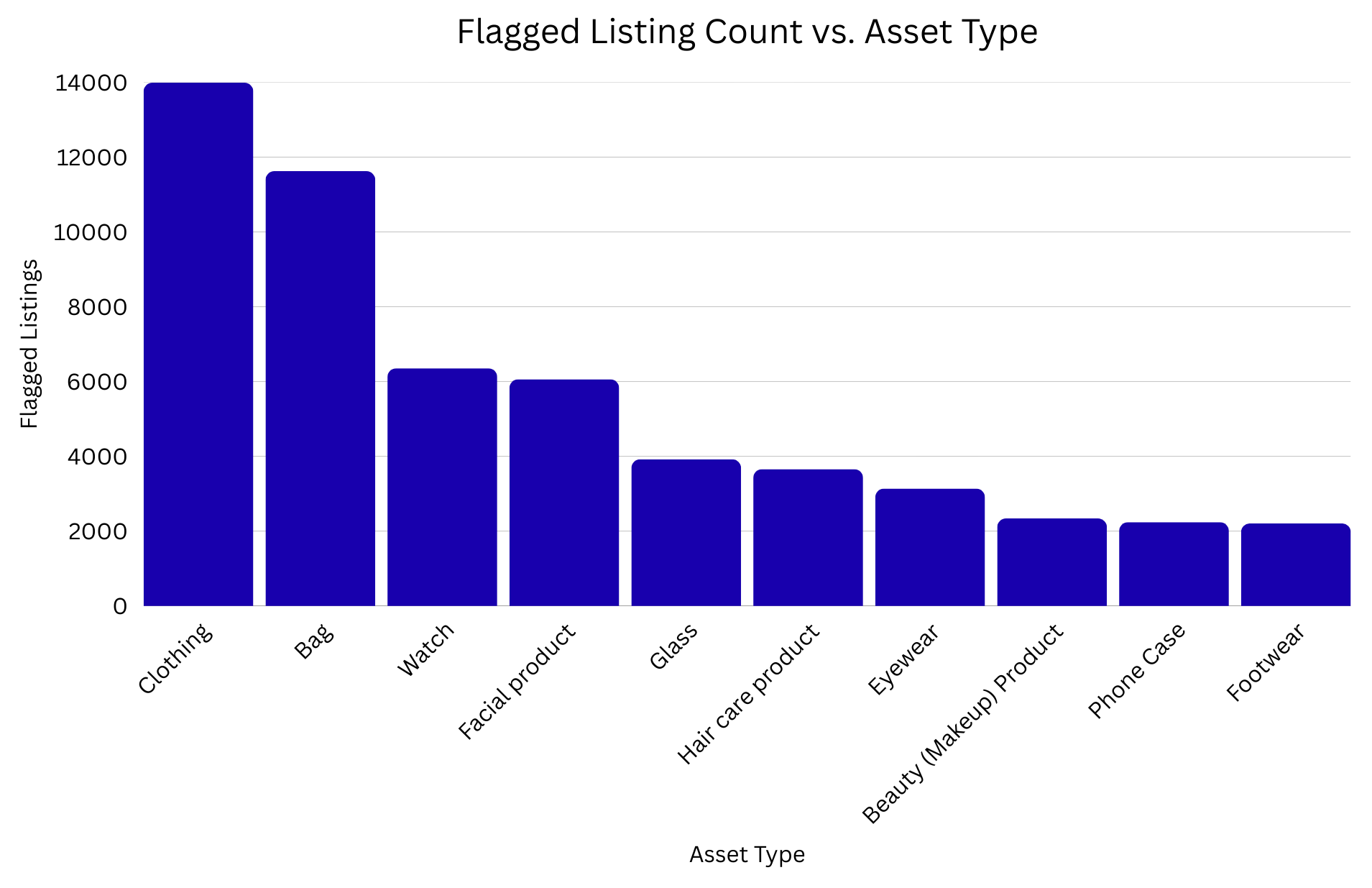The holiday season is supposed to be retail’s brightest moment, featuring gift sets, limited drops, record traffic, and a rush of shoppers hunting for deals. However, behind that excitement is a very different kind of rush: a surge of counterfeiters who treat Black Friday and Cyber Week as their own peak season.
Last year, counterfeit activity spiked sharply, expanded into new categories, and revealed how easily fake products can slip into the chaos of holiday shopping.
Here’s what our holiday data shows, and why brands should pay attention not just now, but all year long.
A Nearly 30% Jump in Counterfeit Losses
One of the clearest patterns was how tightly counterfeit activity tracks consumer demand. During the core Black Friday week, estimated revenue lost to counterfeit sales jumped nearly 30%. For context, that’s millions of dollars in just a few days.
Counterfeiters aren’t guessing. They know:
- Shoppers are moving faster
- Attention is stretched thin
- Lower prices across the board make fakes harder to spot
And because listings move at breakneck speed during holiday promotions, the enforcement system gets overwhelmed. We saw this firsthand: of nearly 100,000 counterfeit listings identified, only about 31% were taken down in time.
A major driver behind that gap was preparedness. Many e-commerce and brand protection teams simply hadn’t allocated budget early enough to scale enforcement. Brands regularly plan months ahead for advertising spend, but protection budgets often lag behind, even though the holiday period is when risk is highest.
Where Counterfeiters Struck the Hardest
Even though fake listings appear across thousands of SKUs, the holiday spike wasn’t random. Instead, it centered around the products most likely to be gifted, unboxed, or showcased during the season.

Fashion dominated the counterfeit landscape.
Clothing, bags, and watches led the season, together making up a huge share of all fake listings. This makes sense: holiday fashion is logo-driven, highly visible, and emotionally tied to gifting. A designer bag on sale or a watch at a steep discount is exactly the bait counterfeiters are hoping shoppers will take.
Beauty continued its rise as a major target.
Facial products, haircare, and makeup made up a meaningful share of all fake listings, an increasingly worrisome trend given the health risks of counterfeit cosmetics. Beauty is especially vulnerable because packaging is easy to mimic and holiday bundles are everywhere.
Glassware unexpectedly surged into the top tier.
This was one of the season’s biggest surprises. Glassware alone accounted for nearly 5% of all counterfeit listings, which is an unusually high number for a category outside of the traditional fashion and apparel counterfeit suspects.
Why glassware? There are a number of potential reasons: holiday hosting, aesthetic gifting, and high visual appeal. It’s a reminder that counterfeiters follow seasonal culture, not just product categories.
All together, the top 10 most-counterfeited items made up two-thirds of all fake listings. In other words, a handful of gifting-friendly products absorbed the bulk of the holiday counterfeit wave.
A Category Imbalance That Tells a Bigger Story
When we zoom out from individual items and look at broader categories, the patterns get even clearer.

Fashion (Apparel & Accessories) was massively overexposed.
These products made up more than half of all reported listings, even though they represent only a fraction of the total product mix. This shows just how heavily counterfeiters rely on recognizable logos and fast-moving SKUs, both of which spike during Black Friday and Cyber Monday.
Home & Kitchen and Miscellaneous items showed a quieter trend.
These categories represent the largest portion of products available online, yet only a small portion of counterfeit activity. That’s actually reassuring: shoppers in these categories care more about functionality than brand, so counterfeiters get less leverage.
But again within Home & Kitchen, a few high-aesthetic subcategories like glassware were clear holiday outliers. That’s the new frontier brands should be monitoring.
What This Year’s Holiday Trends Mean Moving Forward
The holiday season gives us a preview of how counterfeiters will behave in the months and years ahead. Each pattern we observed this season points to a broader shift in how counterfeit operations evolve, diversify, and anticipate consumer behavior. Here’s what these trends signal about the future of brand protection.
1. Counterfeiters are now tracking consumer demand in real time.
The days of counterfeiters copying only the biggest luxury brands or bestsellers are long gone. This season made it clear that counterfeit operations move at the same speed as online shopping trends. If a product category spikes, even temporarily, fake versions appear almost immediately.
When beauty bundles trend on TikTok, counterfeit skincare surges. When a new bag goes viral on Instagram, listings multiply overnight. When holiday promotions push certain products to the top of search results, counterfeiters copy those first. The pattern is unmistakable: counterfeiters are watching the same consumer signals brands rely on, and they’re reacting just as fast.
2. Enforcement bottlenecks have become predictable attack windows.
A removal rate of roughly 31% during peak weeks reflects a structural weakness counterfeiters intentionally exploit. During Black Friday, Cyber Monday, and the weeks leading to Christmas, two things happen simultaneously:
- Marketplace activity skyrockets
- Enforcement teams hit bandwidth limits
Counterfeiters know that during these windows, fake listings can survive longer, sell faster, and slip through unnoticed. They intentionally front-load their activity, flooding platforms with listings because even partial escape from enforcement yields profit.
What brands once viewed as an “unfortunate holiday spike” is now a predictable, engineered strategy on the counterfeit side.
3. Fashion and beauty remain the epicenter of counterfeit risk.
This year reaffirmed a long-standing truth: fashion and beauty are still the most attractive targets for counterfeiters, making up nearly three-quarters of all fake listings we detected.
Why these categories?
- Logo recognition: A simple visual cue can convince a shopper a product is authentic.
- High gifting appeal: Bags, skincare sets, watches, and accessories dominate holiday wish lists.
- Easy replication: Packaging and surface design often carry more weight than material quality in a rushed shopper’s mind.
- Fast purchase cycles: Consumers rarely research deeply before buying fashion or beauty gifts, especially during promotions.
This concentration means brands in these sectors must build always-on protection, not seasonal defenses.
4. Gifting seasons are pushing counterfeiters into new, unexpected categories.
Glassware’s jump into the top five most-counterfeited items this season was a warning sign. As holiday culture evolves, counterfeiters are expanding into any category with aesthetic appeal or gifting potential.
This shift has big implications:
- Counterfeiting is no longer confined to “luxury” goods.
- Counterfeiters are increasingly opportunistic rather than category-bound.
- Seasonal behaviors reshape the risk landscape every year.
If consumers start gifting specialty kitchenware, small décor items, or plant-themed accessories next season, counterfeiters will follow. Their agility is the real threat, and this year proved they can pivot extremely quickly.
5. Brand protection must now extend across entire product ecosystems.
Counterfeiting used to revolve around “hero products,” like the signature bag, the bestselling watch, the iconic fragrance. Those days are over.
This season showed that counterfeiters actively map a brand’s full portfolio and exploit any SKU with recognizability, demand, or gifting appeal. Brands with wide product lines across beauty, accessories, home, or lifestyle saw counterfeiters distributing their activity across dozens of products, not just a few.
This means:
- Protecting one flagship item is no longer enough.
- Counterfeiters see your long-tail SKUs as low-risk, high-reward targets.
- Full-portfolio protection is becoming the new baseline.
For brands, the challenge ahead is safeguarding every product that carries brand equity, no matter how niche.
The Bigger Picture: Holiday Counterfeiting Is Not an Exception
The holiday season is no longer just about driving higher sales volumes. Now, brands must think about navigating a threat landscape that intensifies, diversifies, and accelerates in direct response to consumer behavior.
This year made one thing clear: Counterfeiters are strategic….and the holiday season is when their strategy is on full display.
If you want to understand where your brand is most exposed and how to strengthen your protection before the next seasonal spike, MarqVision can help. Book a demo today.
4 Enforcements a Week to 400: Scale Brand Safety with Marq AI

Don’t Just Find Counterfeits. Dismantle the Entire Network.

.png)
Discover the latest trends and challenges in IP protection

Take Control of Your Trademarks with MARQ Folio

Renew and Manage Your Trademarks Easily With MARQ Folio

We’re waiting to hear from you

See the best brand protection solution in action

Don’t let piracy steal your growth

Talk to us about your brand protection problems

Put an end to impersonating websites
Subscribe to our newsletter
Stay up to date on the latest IP Protection content from MarqVision.
.png)








